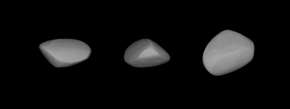158 Koronis is a main-belt asteroid that was discovered by Russian astronomer Viktor Knorre on January 4, 1876, from the Berlin observatory. It was the first of his four asteroid discoveries. The meaning of the asteroid name is uncertain, but it may come from Coronis the mother of Asclepius from Greek mythology. Alternatively, it may come from Coronis, a nymph of the Hyades sisterhood. The Koronis family is named after this asteroid.
From its spectrum this is classified as an S-type asteroid, indicating a stony composition. Photometric observations show a synodic rotation period of 14.206 ± 0.002 hours with a brightness variation of 0.28–0.43 in magnitude. A subsequent study at the Altimira Observatory during 2010 was in agreement with this estimate, yielding a rotation period of 14.208 ± 0.040 hours. Based on a model constructed from the lightcurve, the shape of Koronis resembles that of 243 Ida, an asteroid in the same family, although it is a bit larger.
A collision involving 158 Koronis 15 million years ago created a cluster of 246 objects. 158 Koronis itself retained 98.7% of the total mass. These new objects formed the Koronis(2) family. Koronis(2) is a subfamily of the much larger Koronis family.
References
- ^ "Numbered Minor Planets 1–5000", Discovery Circumstances, IAU Minor Planet center, retrieved 7 April 2013.
- "coronis". Oxford English Dictionary (Online ed.). Oxford University Press. (Subscription or participating institution membership required.)
- McClintock & Strong (1894) Cyclopaedia of Biblical, Theological, and Ecclesiastical Literature
- Yeomans, Donald K., "158 Koronis", JPL Small-Body Database Browser, NASA Jet Propulsion Laboratory, retrieved 12 May 2016.
- "The Asteroid Orbital Elements Database". astorb. Lowell Observatory.
- ^ DeMeo, Francesca E.; et al. (July 2009), "An extension of the Bus asteroid taxonomy into the near-infrared" (PDF), Icarus, 202 (1): 160–180, Bibcode:2009Icar..202..160D, doi:10.1016/j.icarus.2009.02.005, archived from the original (PDF) on March 17, 2014, retrieved 2013-04-08. See appendix A.
- Schmadel, Lutz D. (2012), Dictionary of Minor Planet Names (6th ed.), Springer, p. 27, ISBN 978-3642297182.
- Slivan, Stephen M.; et al. (April 2003), "Spin vectors in the Koronis family: comprehensive results from two independent analyses of 213 rotation lightcurves", Icarus, 162 (2): 285–307, Bibcode:2003Icar..162..285S, CiteSeerX 10.1.1.136.468, doi:10.1016/S0019-1035(03)00029-0.
- Buchheim, Robert K. (July 2011), "Phase Curves of 158 Koronis and 535 Montague", The Minor Planet Bulletin, 38 (3): 128–130, Bibcode:2011MPBu...38..128B.
- Molnar, Lawrence A.; Haegert, M. J. (September 2009), "Details of Recent Collisions of Asteroids 832 Karin and 158 Koronis", American Astronomical Society, DPS meeting #41, #27.05, vol. 41, p. 27.05, Bibcode:2009DPS....41.2705M.
External links
- 158 Koronis at AstDyS-2, Asteroids—Dynamic Site
- 158 Koronis at the JPL Small-Body Database

| Minor planets navigator | |
|---|---|
| Small Solar System bodies | |||||||
|---|---|---|---|---|---|---|---|
| Minor planets |
| ||||||
| Comets | |||||||
| Other | |||||||
